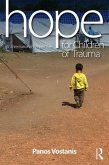- Gebundenes Buch
- Merkliste
- Auf die Merkliste
- Bewerten Bewerten
- Teilen
- Produkt teilen
- Produkterinnerung
- Produkterinnerung
Hope for Children of Trauma: A World Journey synthesizes all the existing evidence, policy and practice from around the world for children and youth who have experienced different forms of complex trauma - such as abuse, neglect and war violence - and also presents a real advance in the literature, by covering new material from the author's extensive visits and collaborations in low- and middle-income countries in Asia, Africa and Latin America.
Andere Kunden interessierten sich auch für
![Hope for Children of Trauma Hope for Children of Trauma]() Panos VostanisHope for Children of Trauma53,99 €
Panos VostanisHope for Children of Trauma53,99 €![The Untapped Power of Discovery The Untapped Power of Discovery]() Karen Golden-BiddleThe Untapped Power of Discovery170,99 €
Karen Golden-BiddleThe Untapped Power of Discovery170,99 €![Trauma and Play Therapy Trauma and Play Therapy]() Paris Goodyear-BrownTrauma and Play Therapy150,99 €
Paris Goodyear-BrownTrauma and Play Therapy150,99 €![Treating Traumatized Children Treating Traumatized Children]() Danny Brom / Julian Ford / Ruth Pat-Horenczyk (eds.)Treating Traumatized Children155,99 €
Danny Brom / Julian Ford / Ruth Pat-Horenczyk (eds.)Treating Traumatized Children155,99 €![Supporting the Family Business Supporting the Family Business]() Manfusa ShamsSupporting the Family Business166,99 €
Manfusa ShamsSupporting the Family Business166,99 €![Recovering Boarding School Trauma Narratives Recovering Boarding School Trauma Narratives]() Christine JackRecovering Boarding School Trauma Narratives177,99 €
Christine JackRecovering Boarding School Trauma Narratives177,99 €![Group Analysis: Working with Staff, Teams and Organizations Group Analysis: Working with Staff, Teams and Organizations]() Group Analysis: Working with Staff, Teams and Organizations150,99 €
Group Analysis: Working with Staff, Teams and Organizations150,99 €-
-
-
Hope for Children of Trauma: A World Journey synthesizes all the existing evidence, policy and practice from around the world for children and youth who have experienced different forms of complex trauma - such as abuse, neglect and war violence - and also presents a real advance in the literature, by covering new material from the author's extensive visits and collaborations in low- and middle-income countries in Asia, Africa and Latin America.
Produktdetails
- Produktdetails
- Verlag: Taylor & Francis
- Seitenzahl: 162
- Erscheinungstermin: 20. März 2018
- Englisch
- Abmessung: 234mm x 156mm x 11mm
- Gewicht: 426g
- ISBN-13: 9781138205642
- ISBN-10: 1138205648
- Artikelnr.: 52210842
- Herstellerkennzeichnung
- Libri GmbH
- Europaallee 1
- 36244 Bad Hersfeld
- gpsr@libri.de
- Verlag: Taylor & Francis
- Seitenzahl: 162
- Erscheinungstermin: 20. März 2018
- Englisch
- Abmessung: 234mm x 156mm x 11mm
- Gewicht: 426g
- ISBN-13: 9781138205642
- ISBN-10: 1138205648
- Artikelnr.: 52210842
- Herstellerkennzeichnung
- Libri GmbH
- Europaallee 1
- 36244 Bad Hersfeld
- gpsr@libri.de
Panos Vostanis is a is Professor of Child Mental Health at the University of Leicester and Visiting Professor at University College London.
Hope for Children of Trauma: A World Journey
Panos Vostanis
Taylor & Francis
Table of Contents
PREFACE
CHAPTER 1: Ever Changing Approaches to Child Trauma
Evolving concepts and attitudes towards children, trauma and mental health
Complex trauma and its correlates
Status and sources of evidence
The whole is larger than the sum of parts: Why service modelling matters
CHAPTER 2: Impact of Trauma on Child Mental Health
The complex relationship between vulnerability and trauma
Nature and extent of mental health problems
Changing approaches to vulnerability and resilience
The increasing influence of socioecological and resilience theories
Inter-linked vulnerability and resilience factors through an ecological
lens
Conceptualizing resilience systems and their interactions
CHAPTER 3: Child Vulnerability in a Global Context
How much can we alter a child's life trajectory?
High-income countries: Policy, evidence and emerging models, but "not
everything that shines is gold"
The constant flux of middle-income countries
Low-income, developing or third world countries?
CHAPTER 4: Looking for Answers: From Birmingham Shelters to Mumbai Slums
Societal, cultural and economic changes
Advances in practice and therapeutic approaches
Service models: The weakest link
Why hard-to-reach groups are also hard to research
Principles and components of high-income countries service model for
vulnerable children
Why can we not just translate this model to low- and middle-income
countries?
CHAPTER 5: The Road to WACIT
A Trail Blazer into the unknown
Nearly impossible question, or just our own ignorance?
Exploring readiness of systems and communities, strengths and challenges
Partnerships, evidence and the preliminary WACIT model
Building the model: The second WACIT phase
The 6 Continents in 6 Weeks launch: More than mere symbolism
CHAPTER 6: Level 1: Children's Safety should Permeate Policy, Attitudes and
Environments
Levels and thresholds of safety
Policy and legislation
Implementation in child care practice
Shifting attitudes
Thinking 'child', 'vulnerability' and 'mental health'
Physical environments and people cannot be disentangled
Interprofessional training means interprofessional care
CHAPTER 7: Nurturing Attitudes and Approaches
Parents and extended family
Kinship care: Within-family or external placement?
Adoptive parents: from assessment to permanency
The wide spectrum of residential care staff needs
Community practitioners' multiple roles
CHAPTER 8: Building Resilience at School and in the Community
Life never stops in the therapy room
School-based interventions
Involving communities: Exciting but largely untested opportunities
The role of mentors
A new experience of belonging
Linking emotional literacy with a business nous
The power of religion, religiosity and spirituality
CHAPTER 9: Application of Therapeutic Approaches
'Therapeutic': A widely used and often misunderstood word
Psychoeducation
Behavioural strategies
Family and attachment-based approaches
Trauma-focused strategies: Usually expected, but where does one start and
stop?
Cognitive-behavioural and other applications
CHAPTER 10: Therapeutic Interventions
Making sense of traumatic memories
Therapeutic relief by touching upon the trauma
Indications and misunderstandings of medication
Multimodal programmes and principles
CHAPTER 11: Always a Service Model, whatever the Constraints
Absence of service modelling
Policy encompassing vulnerability
The more 'inter' the better, but without dilution
From joint care pathways to joint care plans
No need for specialists, but rather for specialist competencies
The importance of indirect service activities
Genuine user participation
Are we making impact? The ever growing and changing role of service
evaluation
High-income countries (HIC)
Low- and middle-income countries (LMIC)
CHAPTER 12: Training in a Service Context
Service connotations and principles
Inter-connectedness between training and service provision
Learning objectives and format of delivery
Trauma-related awareness and foundation knowledge
Continuous professional development (CPD) or lifelong learning
Optimizing the deceptively scary use of new technologies
Organizational issues to be considered
EPILOGUE
BOOK REFERENCES BY CHAPTER
Panos Vostanis
Taylor & Francis
Table of Contents
PREFACE
CHAPTER 1: Ever Changing Approaches to Child Trauma
Evolving concepts and attitudes towards children, trauma and mental health
Complex trauma and its correlates
Status and sources of evidence
The whole is larger than the sum of parts: Why service modelling matters
CHAPTER 2: Impact of Trauma on Child Mental Health
The complex relationship between vulnerability and trauma
Nature and extent of mental health problems
Changing approaches to vulnerability and resilience
The increasing influence of socioecological and resilience theories
Inter-linked vulnerability and resilience factors through an ecological
lens
Conceptualizing resilience systems and their interactions
CHAPTER 3: Child Vulnerability in a Global Context
How much can we alter a child's life trajectory?
High-income countries: Policy, evidence and emerging models, but "not
everything that shines is gold"
The constant flux of middle-income countries
Low-income, developing or third world countries?
CHAPTER 4: Looking for Answers: From Birmingham Shelters to Mumbai Slums
Societal, cultural and economic changes
Advances in practice and therapeutic approaches
Service models: The weakest link
Why hard-to-reach groups are also hard to research
Principles and components of high-income countries service model for
vulnerable children
Why can we not just translate this model to low- and middle-income
countries?
CHAPTER 5: The Road to WACIT
A Trail Blazer into the unknown
Nearly impossible question, or just our own ignorance?
Exploring readiness of systems and communities, strengths and challenges
Partnerships, evidence and the preliminary WACIT model
Building the model: The second WACIT phase
The 6 Continents in 6 Weeks launch: More than mere symbolism
CHAPTER 6: Level 1: Children's Safety should Permeate Policy, Attitudes and
Environments
Levels and thresholds of safety
Policy and legislation
Implementation in child care practice
Shifting attitudes
Thinking 'child', 'vulnerability' and 'mental health'
Physical environments and people cannot be disentangled
Interprofessional training means interprofessional care
CHAPTER 7: Nurturing Attitudes and Approaches
Parents and extended family
Kinship care: Within-family or external placement?
Adoptive parents: from assessment to permanency
The wide spectrum of residential care staff needs
Community practitioners' multiple roles
CHAPTER 8: Building Resilience at School and in the Community
Life never stops in the therapy room
School-based interventions
Involving communities: Exciting but largely untested opportunities
The role of mentors
A new experience of belonging
Linking emotional literacy with a business nous
The power of religion, religiosity and spirituality
CHAPTER 9: Application of Therapeutic Approaches
'Therapeutic': A widely used and often misunderstood word
Psychoeducation
Behavioural strategies
Family and attachment-based approaches
Trauma-focused strategies: Usually expected, but where does one start and
stop?
Cognitive-behavioural and other applications
CHAPTER 10: Therapeutic Interventions
Making sense of traumatic memories
Therapeutic relief by touching upon the trauma
Indications and misunderstandings of medication
Multimodal programmes and principles
CHAPTER 11: Always a Service Model, whatever the Constraints
Absence of service modelling
Policy encompassing vulnerability
The more 'inter' the better, but without dilution
From joint care pathways to joint care plans
No need for specialists, but rather for specialist competencies
The importance of indirect service activities
Genuine user participation
Are we making impact? The ever growing and changing role of service
evaluation
High-income countries (HIC)
Low- and middle-income countries (LMIC)
CHAPTER 12: Training in a Service Context
Service connotations and principles
Inter-connectedness between training and service provision
Learning objectives and format of delivery
Trauma-related awareness and foundation knowledge
Continuous professional development (CPD) or lifelong learning
Optimizing the deceptively scary use of new technologies
Organizational issues to be considered
EPILOGUE
BOOK REFERENCES BY CHAPTER
Hope for Children of Trauma: A World Journey
Panos Vostanis
Taylor & Francis
Table of Contents
PREFACE
CHAPTER 1: Ever Changing Approaches to Child Trauma
Evolving concepts and attitudes towards children, trauma and mental health
Complex trauma and its correlates
Status and sources of evidence
The whole is larger than the sum of parts: Why service modelling matters
CHAPTER 2: Impact of Trauma on Child Mental Health
The complex relationship between vulnerability and trauma
Nature and extent of mental health problems
Changing approaches to vulnerability and resilience
The increasing influence of socioecological and resilience theories
Inter-linked vulnerability and resilience factors through an ecological
lens
Conceptualizing resilience systems and their interactions
CHAPTER 3: Child Vulnerability in a Global Context
How much can we alter a child's life trajectory?
High-income countries: Policy, evidence and emerging models, but "not
everything that shines is gold"
The constant flux of middle-income countries
Low-income, developing or third world countries?
CHAPTER 4: Looking for Answers: From Birmingham Shelters to Mumbai Slums
Societal, cultural and economic changes
Advances in practice and therapeutic approaches
Service models: The weakest link
Why hard-to-reach groups are also hard to research
Principles and components of high-income countries service model for
vulnerable children
Why can we not just translate this model to low- and middle-income
countries?
CHAPTER 5: The Road to WACIT
A Trail Blazer into the unknown
Nearly impossible question, or just our own ignorance?
Exploring readiness of systems and communities, strengths and challenges
Partnerships, evidence and the preliminary WACIT model
Building the model: The second WACIT phase
The 6 Continents in 6 Weeks launch: More than mere symbolism
CHAPTER 6: Level 1: Children's Safety should Permeate Policy, Attitudes and
Environments
Levels and thresholds of safety
Policy and legislation
Implementation in child care practice
Shifting attitudes
Thinking 'child', 'vulnerability' and 'mental health'
Physical environments and people cannot be disentangled
Interprofessional training means interprofessional care
CHAPTER 7: Nurturing Attitudes and Approaches
Parents and extended family
Kinship care: Within-family or external placement?
Adoptive parents: from assessment to permanency
The wide spectrum of residential care staff needs
Community practitioners' multiple roles
CHAPTER 8: Building Resilience at School and in the Community
Life never stops in the therapy room
School-based interventions
Involving communities: Exciting but largely untested opportunities
The role of mentors
A new experience of belonging
Linking emotional literacy with a business nous
The power of religion, religiosity and spirituality
CHAPTER 9: Application of Therapeutic Approaches
'Therapeutic': A widely used and often misunderstood word
Psychoeducation
Behavioural strategies
Family and attachment-based approaches
Trauma-focused strategies: Usually expected, but where does one start and
stop?
Cognitive-behavioural and other applications
CHAPTER 10: Therapeutic Interventions
Making sense of traumatic memories
Therapeutic relief by touching upon the trauma
Indications and misunderstandings of medication
Multimodal programmes and principles
CHAPTER 11: Always a Service Model, whatever the Constraints
Absence of service modelling
Policy encompassing vulnerability
The more 'inter' the better, but without dilution
From joint care pathways to joint care plans
No need for specialists, but rather for specialist competencies
The importance of indirect service activities
Genuine user participation
Are we making impact? The ever growing and changing role of service
evaluation
High-income countries (HIC)
Low- and middle-income countries (LMIC)
CHAPTER 12: Training in a Service Context
Service connotations and principles
Inter-connectedness between training and service provision
Learning objectives and format of delivery
Trauma-related awareness and foundation knowledge
Continuous professional development (CPD) or lifelong learning
Optimizing the deceptively scary use of new technologies
Organizational issues to be considered
EPILOGUE
BOOK REFERENCES BY CHAPTER
Panos Vostanis
Taylor & Francis
Table of Contents
PREFACE
CHAPTER 1: Ever Changing Approaches to Child Trauma
Evolving concepts and attitudes towards children, trauma and mental health
Complex trauma and its correlates
Status and sources of evidence
The whole is larger than the sum of parts: Why service modelling matters
CHAPTER 2: Impact of Trauma on Child Mental Health
The complex relationship between vulnerability and trauma
Nature and extent of mental health problems
Changing approaches to vulnerability and resilience
The increasing influence of socioecological and resilience theories
Inter-linked vulnerability and resilience factors through an ecological
lens
Conceptualizing resilience systems and their interactions
CHAPTER 3: Child Vulnerability in a Global Context
How much can we alter a child's life trajectory?
High-income countries: Policy, evidence and emerging models, but "not
everything that shines is gold"
The constant flux of middle-income countries
Low-income, developing or third world countries?
CHAPTER 4: Looking for Answers: From Birmingham Shelters to Mumbai Slums
Societal, cultural and economic changes
Advances in practice and therapeutic approaches
Service models: The weakest link
Why hard-to-reach groups are also hard to research
Principles and components of high-income countries service model for
vulnerable children
Why can we not just translate this model to low- and middle-income
countries?
CHAPTER 5: The Road to WACIT
A Trail Blazer into the unknown
Nearly impossible question, or just our own ignorance?
Exploring readiness of systems and communities, strengths and challenges
Partnerships, evidence and the preliminary WACIT model
Building the model: The second WACIT phase
The 6 Continents in 6 Weeks launch: More than mere symbolism
CHAPTER 6: Level 1: Children's Safety should Permeate Policy, Attitudes and
Environments
Levels and thresholds of safety
Policy and legislation
Implementation in child care practice
Shifting attitudes
Thinking 'child', 'vulnerability' and 'mental health'
Physical environments and people cannot be disentangled
Interprofessional training means interprofessional care
CHAPTER 7: Nurturing Attitudes and Approaches
Parents and extended family
Kinship care: Within-family or external placement?
Adoptive parents: from assessment to permanency
The wide spectrum of residential care staff needs
Community practitioners' multiple roles
CHAPTER 8: Building Resilience at School and in the Community
Life never stops in the therapy room
School-based interventions
Involving communities: Exciting but largely untested opportunities
The role of mentors
A new experience of belonging
Linking emotional literacy with a business nous
The power of religion, religiosity and spirituality
CHAPTER 9: Application of Therapeutic Approaches
'Therapeutic': A widely used and often misunderstood word
Psychoeducation
Behavioural strategies
Family and attachment-based approaches
Trauma-focused strategies: Usually expected, but where does one start and
stop?
Cognitive-behavioural and other applications
CHAPTER 10: Therapeutic Interventions
Making sense of traumatic memories
Therapeutic relief by touching upon the trauma
Indications and misunderstandings of medication
Multimodal programmes and principles
CHAPTER 11: Always a Service Model, whatever the Constraints
Absence of service modelling
Policy encompassing vulnerability
The more 'inter' the better, but without dilution
From joint care pathways to joint care plans
No need for specialists, but rather for specialist competencies
The importance of indirect service activities
Genuine user participation
Are we making impact? The ever growing and changing role of service
evaluation
High-income countries (HIC)
Low- and middle-income countries (LMIC)
CHAPTER 12: Training in a Service Context
Service connotations and principles
Inter-connectedness between training and service provision
Learning objectives and format of delivery
Trauma-related awareness and foundation knowledge
Continuous professional development (CPD) or lifelong learning
Optimizing the deceptively scary use of new technologies
Organizational issues to be considered
EPILOGUE
BOOK REFERENCES BY CHAPTER








